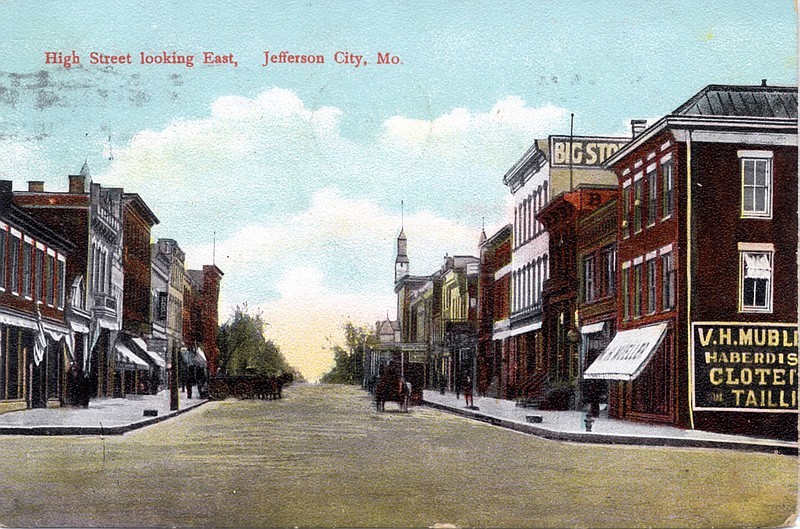When the building at 202 E. High St. was built in the late 1890s, Jefferson City's main commercial thoroughfare had hitching posts and was bustling with horse and carriages. Electric streetlights were not widespread, and the roads were unpaved.
Through the years, 202 E. High St., historically known as the Realty Building, has been a part of Jefferson City's progress and ever-changing streetscape, cycling through nine different owners and 41 different businesses in its 120-year life span.
The site recently has been in the news, due to the unfortunate fact it shares a common wall with 200 E. High St., whose west wall partially collapsed in 2018. This was the result of foundational damage that went undetected.
Many prominent Jefferson Citians have had ties to 202 E. High St. The records begin in 1825 with Alfred Bayse, who purchased the lot from the Commission on Permanent Seat of Government. A man of considerable means, Bayse owned much real estate in the fledgling city. The Bayse mansion at the corner of Madison and State streets, across from the Governor's Mansion, later became the Rising Sun Hotel.
Elias Barcroft bought the lot in 1828. He was deputy surveyor of Missouri and surveyed and mapped a fair portion of the state. He also laid out the City of Jefferson. He was a member of the "Tippecanoe Club." Barcroft died in the cholera epidemic in 1851.
It is uncertain when the first structure was built at 202 E. High St., but the 1868 Bird's Eye View map shows a two-story building. Later, an 1885 Sanborn map shows a stone building. By this time, it was owned by law partners H. Clay Ewing and J. L. Smith. Serving as attorney general and on the Supreme Court, Ewing was also instrumental in securing Jefferson City as the state's Capital and in the organization of Exchange Bank, where he served as president. The bank was located next door at 204 E. High St.
The 1885 and 1892 Sanborn maps indicate a drug store on the site. But by 1898, the stone structure has been replaced with a brick building that abuts the buildings on both sides and appears to have been "inserted" between the two buildings sharing common walls with each.
William A. Dallmeyer purchased 202 E. High St. in January 1898, then sold it the next month to the Exchange Realty Company, thus the name "The Realty Building." The Exchange Realty Company owned the property from 1898-1942. Co-owners of the Realty Company were also connected with the Exchange Bank at 204 E. High St. - Dallmeyer and Ewing, William Q. Dallmeyer (W.A.'s father), and Arthur Hough, all Jefferson City movers and shakers. Among many other achievements, Hough secured the $25,000 donation from Andrew Carnegie to build a library on Adams Street.
The Realty Building housed two street-level storefronts, as well as second-floor offices. Businesses came and went. A partial list includes jewelry store (Theodore Burkhardt), insurance company (William A. Dallmeyer and Lawrence Franz), physician (Malcolm Aldridge), law firm (Thomas Antrobus), chiropractor (Elizabeth Balkenhol), Knights of Pythias Hall, Stokes Electric, Louis Lohman Investments, Underwood Typewriter Company, The Purple Shoppe, Farmer Brothers Coal Company, and C. Gordon Price. The Jefferson City Building and Loan Company was one of the earliest businesses operating out of the building, where it held its shareholders meetings.
In 1942, the Exchange Realty Company sold the building to the trustee of the Arthur Hough estate, who sold it in 1969 to Harold, Margaret and Rita McDowell.
Merle Norman Cosmetics, a fixture in downtown Jefferson City, was first located at 202 E. High St. in 1969. Owner Carolyn McDowell became joint owner of the building from 1989-2004. After several transactions, 202 E. High St. now is owned by Carol Wieberg. MO Juice and Love2Nourish were the last businesses to operate out of 202 E. High St. and were forced to vacate when the west wall of 200 E. High St. collapsed.
In a tangle of opinions and legal proceedings, the fate of 200 and 202 E. High St. remains unresolved. There seems to be agreement that costs to repair 200 E. High St. are prohibitive. However, there are opposing opinions as to the feasibility of sparing 202 E. High St.
It is structurally sound but certainly could not survive losing its west wall, shared with 200 E. High St. A court decision ruled the common wall between 200 and 202 belongs to 200.
Our downtown and its history will be diminished with the inevitable loss of 200. Hopefully, there is some compromise that could be reached to spare 202.
Jenny Smith and Deborah Goldammer have served on the Board of Directors of the Historic City of Jefferson. Goldammer provides historical research for HCJ, and Smith is a retired chemist with the Missouri Highway Patrol Crime Lab.

